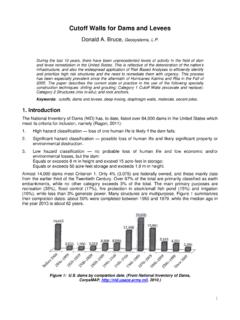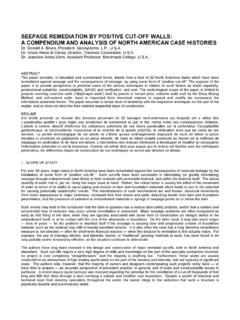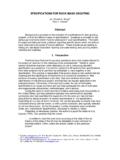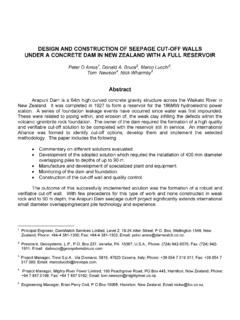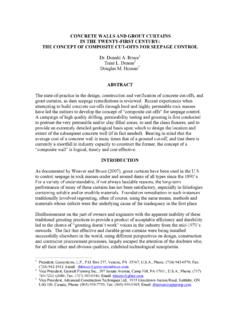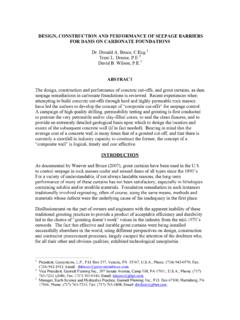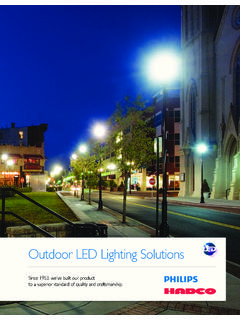Transcription of ROCK ANCHORS FOR DAMS: EVOLUTION AND …
1 ROCK ANCHORS FOR dams : EVOLUTION AND ANALYSIS OF corrosion protection SYSTEMS AND construction COSTS Dr. Donald A. Bruce1 and John S. Wolfhope2 Abstract In recent ASDSO conferences, the authors have presented the results of Phase 1 of the National Research Program into prestressed rock ANCHORS for dams . This paper specially addresses two key issues which the authors observe are of prime interest to engineers considering dam remediation using prestressed ANCHORS , namely corrosion protection (and, hence, anticipated longevity) and project costs. The conclusions are drawn from a study of over 400 case histories and 230 technical papers which have been collected on North American practice in the course of the Phase 1 studies. 1. Introduction Two of the most commonly asked questions when contemplating a dam anchoring project are: How long will the ANCHORS last? and How much do they cost? As is well known to members of the Association of State Dam Safety Officials through previous related papers ( , Bruce and Wolfhope 2005, and 2006), the authors have compiled a database of over 400 dam anchor projects completed in North America from 1968 to 2004.
2 They have also reviewed the five successive phases of Recommendations provided as quasi-industry standards by the Post Tensioning Institute (PTI), and its predecessor, between 1974 and 2004, and have further compiled a collection of 230 technical papers authored on North American dam anchor projects to date. The purpose of this paper is to help answer the two key questions posed above. 2. corrosion protection and anchor Longevity What the Recommendations Said Ground ANCHORS had been used in the since the early 1960 s primarily as temporary tie backs and as permanent installations for dams since 1968. With the rapid growth of the market at that time, there was a clear need to establish some type of nationally 1 President, Geosystems, , Box 237, Venetia, PA 15367, , Phone: (724) 942-0570, Fax: (724) 942-1911, Email: 2 Principal, Freese and Nichols, Inc., 10814 Jollyville Road, Building 4, Suite 100, Austin, TX 78759-5674, ; Phone: (512) 617-3118; Fax: (512) 451-7956; Email: acknowledged, unifying, guidance document, especially since the drivers of the industry (principally post tensioning specialists) each promoted his own proprietary philosophies and systems: these often merely parroted the mantra of the European country of their corporate headquarters.
3 Such systems were also primarily off the shelf having been developed for post-tensioning applications other than geotechnical, or dam remediation. The first such American document was published in 1974 by the Post Tensioning Division of the Prestressed Concrete Institute. This Division soon thereafter broke away to form the Post Tensioning Institute, and later published successive sets of Recommendations documents in 1980, 1986, 1996 and 2004. Although certain states, agencies and, indeed even consultants, have traditionally issued their own anchor specifications, there is no doubt that the PTI documents are the national reference point and, as such, have been embraced and/or endorsed by the Federal Highways Administration (FHWA), the Army Corps of Engineers (USACE), the Bureau of Reclamation (USBR) and The International Association of Foundation Drilling (ADSC), amongst numerous others. A most telling observation is the amount of attention paid to corrosion and corrosion protection in the successive Recommendations: 1974 Edition 1 page 1980 Edition 4 pages 1986 Edition 5 pages 1996 Edition 10 pages 2004 Edition 14 pages (plus a 10-page supplement on epoxy protected strand) Key features from these successive Recommendations can be summarized as follows: 1974.
4 Figure 1 illustrates the very simple approach to tendon protection , , grout or nothing. Permanent is defined as generally more than a 3-year service life. Sheathing is only discussed as a debonding medium, not a corrosion protection barrier. For permanent ANCHORS protective corrosion seals over their entire length are to be provided (but are not defined). For two stage grouted tendons, sheathing can be omitted, the implication being that grout alone would be acceptable. 1980. The same Figure 1 is reproduced (as it was also in 1986). The term permanent is now reduced to 18 months or more, and growing attention is drawn to the requirements of permanent ANCHORS : sheathing is for debonding and/or to provide corrosion protection , as is secondary grout. Corrugated protection , and epoxy coating for bars are discussed. The type and details of corrosion protection are to be based on longevity, anchor environment, consequences of future and in-hole conditions/length of time before grouting.
5 For the bond length, grout is considered the first level of corrosion protection , and plastic corrugated sheathing ( for multiple corrosion protection schemes ) or epoxy are permitted. Such protection is to extend at least 2 feet into the free length. The free length is to have, as a minimum, a sheath with grout or grease infill. A full length outer sheath is regarded as good practice. 1986. The emphasis is placed on first investigating the chemical aggressiveness of the soil and ground water: Permanent ANCHORS placed in environments where any one of these tests indicate critical values must be encapsulated over their full length. Thus, even up until the next set of Recommendations (1996), it was considered acceptable to allow ANCHORS for dams to be installed without any protection for the bond length other than grout, depending on the results of laboratory tests on small samples. Encapsulation was not detailed. Figure 1. Rock anchor Components (PCI, 1974). (Note the lack of protection to the steel other than grout.)
6 1996. Permanence is now defined as a minimum of 24 months in a completely revised set of Recommendations. A wider spectrum of issues than simple chemistry now have to be considered when selecting corrosion protection principles. A major breakthrough was to identify two classes of protection (Class I and II) for permanent ANCHORS to replace the poorly defined and loosely used double and single corrosion protection systems offered by various tendon manufacturers. The details are summarized in Table 1 and a decision tree (Figure 2) was provided for the guidance of designers. Table 1. corrosion protection Requirements (PTI, 1996). Figure 2. corrosion protection Decision Tree (PTI, 1996). 2004. The existing Recommendations were revalidated while it is stated that, for permanent ANCHORS , aggressive conditions shall be assumed if the aggressivity of the ground has not been quantified by testing. Table 1 was revised, as shown in Table 1R, mainly to clarify the Class I status of epoxy protected steel in a water proofed hole.
7 The sophistication of contemporary tendons is shown in Figure 3 and 4. A long supplement is devoted to epoxy protected strand. Table 1R. corrosion protection Requirements (PTI, 2004). Figure 3. Class I protection Encapsulated Strand anchor (PTI, 2004). Figure 4. Class I protection Epoxy Coated Strand anchor (PTI, 2004). Overall, therefore, one is impressed that between 1974 and 2006 (i) extremely sophisticated corrosion protection systems were developed and (ii) the latitude offered to designers relative to choice of corrosion protection intensity and details was severely restricted: to install a permanent anchor in a dam without Class I protection is now not only impermissible, but unthinkable. It must also be noted that the philosophy of pregrouting and redrilling the hole ( waterproofing ) if it were to fail a permeability test was restated from 1974 onwards: indeed the early pass-fail acceptance criteria were, in fact, very rigorous and led to most ANCHORS on most projects having to be pregrouted and redrilled several times.
8 Although laudable, this was often, in fact, extra work since the criterion to achieve grout tightness is really much more lax than the criterion needed to provide the specified degree of water tightness. The saving grace of many of the early ANCHORS was doubtless, therefore, the somewhat erroneous waterproofing criterion under which they were constructed. What the Technical Press Said When analyzing the 230 technical papers devoted to dam anchoring in North America to date, one occasionally wins fascinating insights into contemporary thinking regarding corrosion protection issues. The following is provided by way of illustration: no commentary is necessary. No claim is made that this is anything other than a sampling of the whole. Thompson (1969) (John Hollis Bankhead Dam, AL, 1969). Based on chemical analyses of the groundwater ..the laboratory concluded that the risk of corrosion would probably be no more than that of a coal free environment. During the 12 months when the ANCHORS were loaded [ , primary grouted and stressed only] their wires and the grout pipe developed corroded areas just below the anchor head.
9 The wires subjected to flowing water had lost considerably more weight per unit of length than the wires in the still water..it was concluded that a good cover of cement grout would adequately protect the anchor wires. ENR (1971) (Ryan Dam, MT, 1970)..the stressing length of the anchor was filled with grout to protect against corrosion . Buro (1972) (Libby Dam, MT, 1971). After all the stressing procedures were completed, the anchor was secondary grouted that is, the space between the top of the bond length and the stressing anchorage was filled with grout to provide the steel with positive and complete protection against corrosion . The concept of providing a greased and sheathed free length for measuring ANCHORS is introduced. Bruce (2003) (Rocky Ridge Dam WA, 1975). This dam had been anchored with fully bonded multiwire tendons in 1975. With considerable foresight on the part of the designers, four ANCHORS were equipped with greased and sheathed minitendons, each comprising 4 wires, which could be lifted-off in the future.
10 This information would hopefully be illustrative of the performance of the other wires in the other tendons also. (Performance to date has, in fact, been excellent.) Sharma and Sasaki (1985) (Pacoima Dam, CA, 1976). Eight of 35 ANCHORS were equipped with hydraulic lift-off load cells to monitor the working force in the stressed tendons. The monitored ANCHORS were greased and sheathed with plastic tubing in the stressed secondary zone to insure free movement. All ANCHORS were grouted in the secondary zone to provide corrosion protection . Troka and Lane (1988) (Bagnell Dam, MO, 1982). Also, since second stage grouting would arrest any further Standig (1984) (Delta Dam, NY, 1983). A double corrosion system includes a continuous plastic duct enclosing the strands, in addition to grout. Single stage grouting was specified, with grout being placed by the tremie method up from the bottom of the hole, around the strands between the duct and the drill hole simultaneously.
